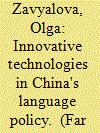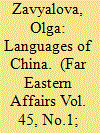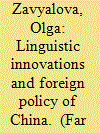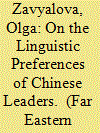|
|
|
Sort Order |
|
|
|
Items / Page
|
|
|
|
|
|
|
| Srl | Item |
| 1 |
ID:
164064


|
|
|
|
|
| Summary/Abstract |
Improvements in artificial intelligence are considered by the Chinese leadership one of the strategic spheres of state development. Modern linguistic technologies are being broadly introduced by Chinese linguists in the country. In the near future, they will also be used as "soft power" for creating an attractive image of China in foreign countries.
|
|
|
|
|
|
|
|
|
|
|
|
|
|
|
|
| 2 |
ID:
189311


|
|
|
|
|
| Summary/Abstract |
The official list of ethnic groups of the People's Republic of China, begun in the 1950s and completed in 1979, included and still includes 56 groups speaking a total of 54 languages. Extensive field research in recent years has shown that the ethnic and linguistic picture of the country is in fact much more complex and diverse than had been imagined until the late 1970s. China remains one of the most linguistically diverse countries in the world, but many minority languages and varieties of Chinese dialects, both previously known and newly discovered, are now spoken only by a few thousand, a few dozen, or even a handful of older locals. The most important task set by the Chinese state for linguists is to further study, with electronic preservation, the numerous languages of minority ethnic groups, any Chinese dialects, and, more recently, samples of local spiritual and material culture. From 2015 to 2019, an ambitious China Language Resource Preservation Program was implemented. The materials collected during field research, including those on endangered language varieties, have been presented in numerous publications and used to create a unique online platform available to linguists and partially to ordinary Internet users. The next phase of the study and preservation of China's linguistic and cultural heritage was initiated by the government in 2020. A document devoted entirely to language problems and language policy was published by the Office of the State Council of the People's Republic of China in 2021.
|
|
|
|
|
|
|
|
|
|
|
|
|
|
|
|
| 3 |
ID:
156600


|
|
|
|
|
| Summary/Abstract |
In the epoch of modern information technologies, China remains an exceptionally diversified country linguistically. The implementation of the nationalities policy is inseparable from the study of the languages of the different peoples inhabiting the PRC. Major linguistic research is an important component of programs aimed at the preservation of the non-material cultural heritage of the country. After the proclamation of the One Belt, One Road strategy in 2013, the study of transborder languages , which exist on the territories of neighboring countries, has acquired special importance.
|
|
|
|
|
|
|
|
|
|
|
|
|
|
|
|
| 4 |
ID:
146032


|
|
|
|
|
| Summary/Abstract |
Linguistic policy, which includes not only a domestic, but also a foreign component, was revived in China after a long interval only at the beginning of this century. Since 2004, the official Chinese language Putonghua (based on the Beijing dialect of Mandarin) and traditional Chinese culture have been popularized all over the world as soft power. In 2013, a new stage began of using linguistics to solve tasks of foreign policy. It was prompted by the emergence of Xi Jinping's One Belt, One Road strategy and envisaged the active study of the languages of countries surrounding China, along with the cross-border languages of the PRC peoples.
|
|
|
|
|
|
|
|
|
|
|
|
|
|
|
|
| 5 |
ID:
192510


|
|
|
|
|
| Summary/Abstract |
Chinese leaders have been attuned to language issues for centuries. In his speech at the 20th CPC Congress, Xi Jin-ping mentioned the continued promotion of the Putonghua official language and the standard Chinese character writing system as the main task of the country's language policy. Promoting traditional culture and preserving ancient written texts is another important task in modern China. It is no coincidence that soon after the 20th Congress, Xi Jinping visited excavations and a museum park at Yinxu, the site of the capital of the second period of the Shang-Yin Dynasty, where the most ancient jiaguwen Chinese inscriptions have been discovered. In the current period of revival of philological traditions, Xi Jinping's signature in his own calligraphic version with the traditional, non-simplified character 習 xí is widely used in Chinese propaganda. The importance of popularizing Chinese language and culture outside the country was discussed in a letter that Xi Jinping sent to a group of students from Saudi Arabia soon after the 20th Congress. As for the Hanyu Pinyin romanization system for Standard Mandarin Chinese, introduced in the PRC in 1958 - it is either positioned in official documents as an auxiliary means to be used in Chinese primary schools for writing Chinese words in foreign language texts and teaching Chinese to foreigners, or it is not mentioned at all.
|
|
|
|
|
|
|
|
|
|
|
|
|
|
|
|
|
|
|
|
|